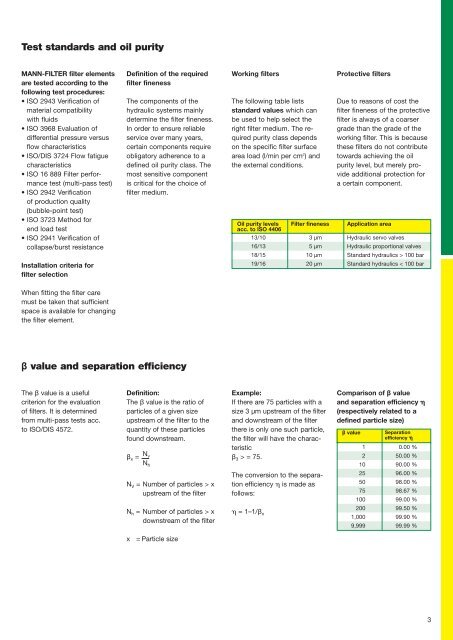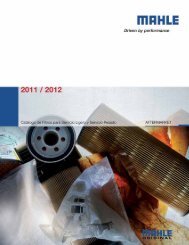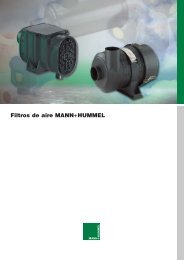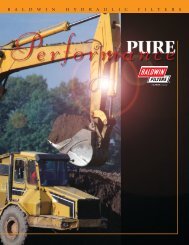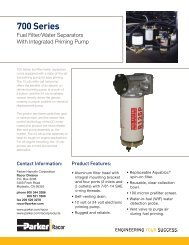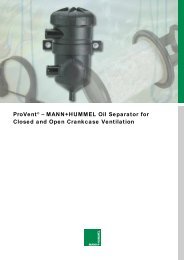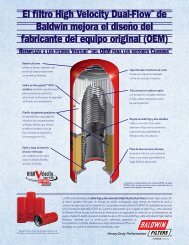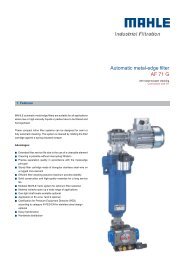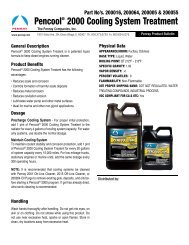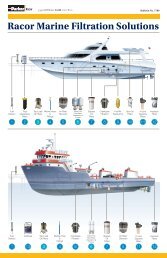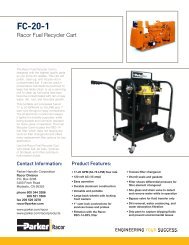Hydraulik Broschüre_GB - MANN+HUMMEL
Hydraulik Broschüre_GB - MANN+HUMMEL
Hydraulik Broschüre_GB - MANN+HUMMEL
You also want an ePaper? Increase the reach of your titles
YUMPU automatically turns print PDFs into web optimized ePapers that Google loves.
Test standards and oil purity<br />
MANN-FILTER filter elements<br />
are tested according to the<br />
following test procedures:<br />
• ISO 2943 Verification of<br />
material compatibility<br />
with fluids<br />
• ISO 3968 Evaluation of<br />
differential pressure versus<br />
flow characteristics<br />
• ISO/DIS 3724 Flow fatigue<br />
characteristics<br />
• ISO 16 889 Filter performance<br />
test (multi-pass test)<br />
• ISO 2942 Verification<br />
of production quality<br />
(bubble-point test)<br />
• ISO 3723 Method for<br />
end load test<br />
• ISO 2941 Verification of<br />
collapse/burst resistance<br />
Definition of the required<br />
filter fineness<br />
The components of the<br />
hydraulic systems mainly<br />
determine the filter fineness.<br />
In order to ensure reliable<br />
service over many years,<br />
certain components require<br />
obligatory adherence to a<br />
defined oil purity class. The<br />
most sensitive component<br />
is critical for the choice of<br />
filter medium.<br />
Working filters<br />
The following table lists<br />
standard values which can<br />
be used to help select the<br />
right filter medium. The required<br />
purity class depends<br />
on the specific filter surface<br />
area load (l/min per cm 2 ) and<br />
the external conditions.<br />
Oil purity levels<br />
acc. to ISO 4406<br />
13/10<br />
16/13<br />
Filter fineness<br />
3 µm<br />
5 µm<br />
Protective filters<br />
Due to reasons of cost the<br />
filter fineness of the protective<br />
filter is always of a coarser<br />
grade than the grade of the<br />
working filter. This is because<br />
these filters do not contribute<br />
towards achieving the oil<br />
purity level, but merely provide<br />
additional protection for<br />
a certain component.<br />
Application area<br />
Hydraulic servo valves<br />
Hydraulic proportional valves<br />
18/15<br />
10 µm<br />
Standard hydraulics > 100 bar<br />
Installation criteria for<br />
filter selection<br />
19/16<br />
20 µm<br />
Standard hydraulics < 100 bar<br />
When fitting the filter care<br />
must be taken that sufficient<br />
space is available for changing<br />
the filter element.<br />
β value and separation efficiency<br />
The β value is a useful<br />
criterion for the evaluation<br />
of filters. It is determined<br />
from multi-pass tests acc.<br />
to ISO/DIS 4572.<br />
Definition:<br />
The β value is the ratio of<br />
particles of a given size<br />
upstream of the filter to the<br />
quantity of these particles<br />
found downstream.<br />
β x = N v<br />
N h<br />
Example:<br />
If there are 75 particles with a<br />
size 3 µm upstream of the filter<br />
and downstream of the filter<br />
there is only one such particle,<br />
the filter will have the characteristic<br />
β 3 > = 75.<br />
Comparison of β value<br />
and separation efficiency <br />
(respectively related to a<br />
defined particle size)<br />
β value<br />
1<br />
2<br />
10<br />
Separation<br />
efficiency <br />
0.00 %<br />
50.00 %<br />
90.00 %<br />
N V = Number of particles > x<br />
upstream of the filter<br />
The conversion to the separation<br />
efficiency is made as<br />
follows:<br />
25<br />
50<br />
75<br />
100<br />
96.00 %<br />
98.00 %<br />
98.67 %<br />
99.00 %<br />
N h = Number of particles > x<br />
downstream of the filter<br />
= 1–1/β x<br />
200<br />
1,000<br />
9,999<br />
99.50 %<br />
99.90 %<br />
99.99 %<br />
x = Particle size<br />
3


